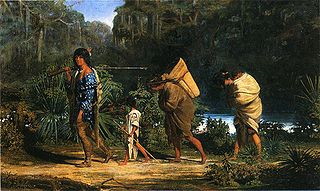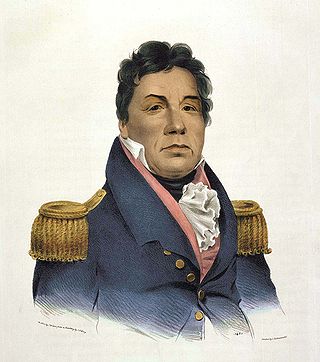Current tribes
Indian termination policy was a policy that the United States Congress legislated in 1953 to assimilate the Native American communities with mainstream America. In 1959, the Choctaw Termination Act was passed. [2] Unless repealed by the federal government, the Choctaw Nation of Oklahoma would effectively be terminated as a sovereign nation as of August 25, 1970. [2]
After a long struggle for recognition, the Mississippi Choctaw received recognition in 1918. The Mississippi Choctaw soon received lands, educational benefits, and a long overdue health care system.
In 1945, lands in Neshoba County, Mississippi and the surrounding counties were set aside as a federal Indian reservation. There are eight communities of reservation land: Bogue Chitto, Bogue Homa, Conehatta, Crystal Ridge, Pearl River, Red Water, Tucker, and Standing Pine. The Indian Reorganization Act of 1934 allowed the Mississippi Choctaws to become re-organized on April 20, 1945 as the Mississippi Band of Choctaw Indians.
Oklahoma Choctaws
Choctaw Nation of Oklahoma
Mississippi Choctaws
Pre-reorganization Era (Before 1945)
- Wesley Johnson (Wesley Wakatubee), 1913-c. 1914 (Chief)
- Ed Willis
- Pat Chitto
- Joe Chitto
Mississippi Band of Choctaw Indians (1945-Present)
Louisiana Choctaws
Jena Band of Choctaw Indians
- Christina M. Norris, present [4]

The Choctaw are a Native American people originally based in the Southeastern Woodlands, in what is now Alabama and Mississippi. Their Choctaw language is a Western Muskogean language. Today, Choctaw people are enrolled in three federally recognized tribes: the Choctaw Nation of Oklahoma, Mississippi Band of Choctaw Indians, and Jena Band of Choctaw Indians in Louisiana.

Greenwood LeFlore or Greenwood Le Fleur served as the elected Principal Chief of the Choctaw in 1830 before removal. Before that, the nation was governed by three district chiefs and a council of chiefs. A wealthy and regionally influential Choctaw of mixed-race, who belonged to the Choctaw elite due to his mother's rank, LeFlore had many connections in state and federal government. In 1830 LeFlore led other chiefs in signing the Treaty of Dancing Rabbit Creek, which ceded the remaining Choctaw lands in Mississippi to the US government and agreed to removal to Indian Territory. It also provided that Choctaw who chose to stay in Mississippi would have reserved lands, but the United States government failed to follow through on this provision.

The Choctaw Nation is a Native American territory covering about 6,952,960 acres, occupying portions of southeastern Oklahoma in the United States. The Choctaw Nation is the third-largest federally recognized tribe in the United States and the second-largest Indian reservation in area after the Navajo. As of 2011, the tribe has 223,279 enrolled members, of whom 84,670 live within the state of Oklahoma and 41,616 live within the Choctaw Nation's jurisdiction. A total of 233,126 people live within these boundaries, with its tribal jurisdictional area comprising 10.5 counties in the state, with the seat of government being located in Durant, Oklahoma. It shares borders with the reservations of the Chickasaw, Muscogee, and Cherokee, as well as the U.S. states of Texas and Arkansas. By area, the Choctaw Nation is larger than eight U.S. states.

Mushulatubbee was the chief of the Choctaw Okla Tannap, one of the three major Choctaw divisions during the early 19th century. When the Principal Chief Greenwood LeFlore stayed in Mississippi at the time of removal, Mushulatubbee was elected as principal chief, leading the tribe to Indian Territory.

Pushmataha, the "Indian General", was one of the three regional chiefs of the major divisions of the Choctaw in the 19th century. Many historians considered him the "greatest of all Choctaw chiefs". Pushmataha was highly regarded among Native Americans, Europeans, and white Americans, for his skill and cunning in both war and diplomacy.

George Washington Harkins was an attorney and prominent chief of the Choctaw tribe during Indian removal.

The Treaty of Doak's Stand was signed on October 18, 1820 between the United States and the Choctaw Indian tribe. Based on the terms of the accord, the Choctaw agreed to give up approximately one-half of their remaining Choctaw homeland. In October 1820, Andrew Jackson and Thomas Hinds were sent as commissioners who represented the United States to negotiate a treaty to surrender a large portion of Choctaw country in Mississippi. They met with tribal representatives at Doak's Stand on the Natchez Trace. They met with the chiefs Pushmataha, Mushulatubbee, and Apuckshunubbee, who represented the three major regional divisions of the Choctaw. Chiefs of the towns and other prominent men accompanied them, such as Colonel Silas Dinsmoor.
Beasley Denson served as Miko or Tribal Chief of the Mississippi Band of Choctaw Indians from 2007 to 2011. He is the third person to be elected as Tribal Chief since the tribe adopted its modern constitution. Beasley Denson defeated 28-year incumbent Phillip Martin by 211 votes, receiving 1,697 votes compared to Martin's 1,486.

Peter Perkins Pitchlynn was a Choctaw chief of Choctaw and Anglo-American ancestry. He was principal chief of the Choctaw Republic from 1864-1866 and surrendered to the Union on behalf of the nation at the end of the Civil War.

The Treaty of Washington City was a treaty signed on January 20, 1825 between the Choctaw and the United States Government.
Apuckshunubbee was one of three principal chiefs of the Choctaw Native American tribe in the early nineteenth century, from before 1800. He led the western or Okla Falaya District of the Choctaw, of which the eastern edge ran roughly southeast from modern Winston County to Lauderdale County, then roughly southwest to Scott County, then roughly south-southeast to the western edge of Perry County. His contemporaries were Pushmataha and Moshulatubbee, who respectively led the southern district Okla Hannali and the north-eastern district Okla Tannap.

Greenwood "Green" McCurtain was a tribal administrator and Principal Chief of the Choctaw Republic, serving a total of four elected two-year terms. He was the third of his brothers to be elected as chief. He was a Republican in the late 19th century, leaning toward allotment and assimilation when the nation was under pressure by the United States government, as he believed the Choctaw needed to negotiate to secure their best outcome prior to annexation.
Honobia is an unincorporated community on the border between western LeFlore County and eastern Pushmataha County, Oklahoma, United States, 15 miles southeast of Talihina.
Nashoba County was a political subdivision of the Choctaw Nation of Indian Territory. The county formed part of the Nation’s Apukshunnubbee District, or Second District, one of three administrative super-regions in the Nation. This territory was later made part of the state of Oklahoma.
Apukshunnubbee District was one of three administrative super-regions comprising the former Choctaw Nation in Indian Territory. Also called the Second District, it encompassed the southeastern one-third of the nation.

Moshulatubbee District was one of three administrative super-regions comprising the former Choctaw Nation in the Indian Territory. Also called the First District, it encompassed the northern one-third of the nation. In some historic records it is spelled Mushulatubbe.

Pushmataha District was one of three administrative super-regions comprising the former Choctaw Nation in the Indian Territory. Also called the Third District, it encompassed the southwestern one-third of the nation.
Wade County was a political subdivision of the Choctaw Nation of Indian Territory, prior to Oklahoma being admitted as a state. The county formed part of the Nation's Apukshunnubbee District, or First District, one of three administrative super-regions.

Pigeon Roost is a ghost town in Choctaw County, Mississippi.

Harry James Watson "Jimmy" Belvin was an educator and served as an Oklahoma State Representative and Senator. He was the first elected principal chief of any of the Five Civilized Tribes in the 20th century, and the longest serving principal chief of the Choctaw Nation of Oklahoma. He saw his tribe through termination, restoration, and a rebirth of Native Pride. He was a polarizing leader, seen by some as a semi-dictator who held onto the office of principal chief and used his power to advocate for complete assimilation into the dominant society, suppressing Choctaw traditions, language and ceremonial practices as undesirable remnants of an unrefined history. To others, he was a well-liked, populist leader, who went door-to-door talking with tribe members, informing them on issues, and trying to develop the means the alleviate the poverty and unemployment they faced.


















